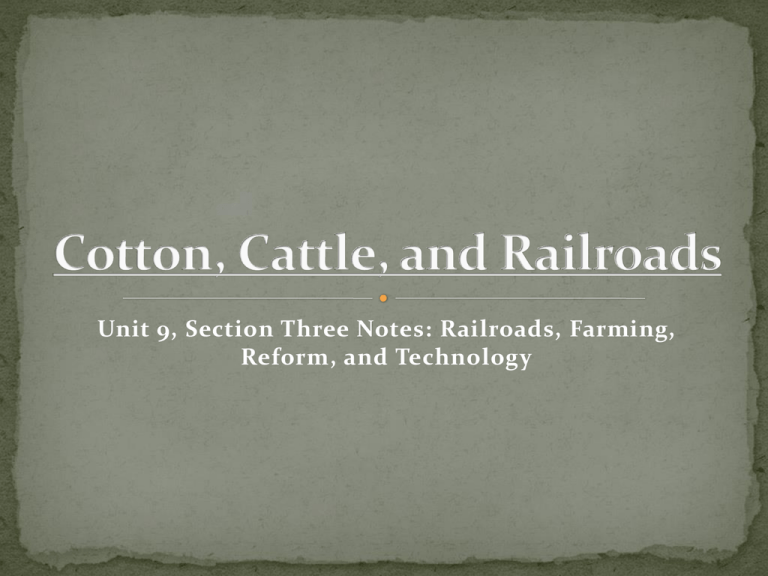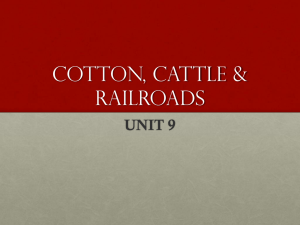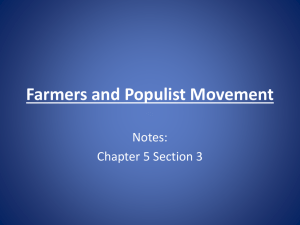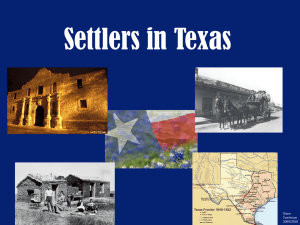Unit 9, Section Three Notes
advertisement

Unit 9, Section Three Notes: Railroads, Farming, Reform, and Technology In the 1870’s, farmers were struggling to survive. After years of falling prices due to supply exceeding demand, most farmers were greatly in debt to merchants from which they borrowed money. As they dealt with droughts and other issues, they also had to compete with foreign competition and high interest rates on the loans they took out. Many simply couldn’t go on. Because of serious transportation problems, economic growth in Texas was slow. Texans were eager to build more railroads throughout the state, since they provided cheap, fast, and reliable transportation of people and goods. By 1870, the U.S. had a transcontinental railroad. Texas was far behind the rest of the U.S. in the miles of track. Local towns and the state government began setting aside land and funding the building of railroads. There was a demand for cheap and reliable transportation. Railroads promised new business opportunities. Along with railroads came the growth of agriculture and industry in Texas. Cities and counties began setting aside money for the building of railroads. The state set aside land grants for the railway lines. More settlements in Texas were built in the West Texas frontier. Cities began to grow that were along the railway lines. Cities that were not along railway lines saw a decline in population and business. New jobs were created in Texas because of the railroad industry. The agriculture industry in Texas grew even more with the ability to send goods to other markets on the railroads, while cattle drives all but disappeared. With the growth of the railroad industry, many farmers began to move into west Texas during the late 1800’s. Many crops grew well in the drier climate, like wheat and sorghum. To deal with the dry weather, many farmers used windmills to pump water from aquifers for crop irrigation. They also used the new John Deere tractor to break through the hard top soil to get to the rich soil below. New machinery and the growth of railroads led to commercial farming, or the large-scale growth of crops to sell for profit. Farmers began to just produce one kind of crop, such as cotton, instead of many. But as farmers grew more crops, supply began to exceed the demand, so prices fell and farmers were left with cotton that could not be sold for the price they wanted. Because of the drop in prices, a boll weevil problem, and a drought, many farmers found that they were not making enough money to pay for the cost of running a farm. In the late 1860’s, many farmers joined together to establish a group commonly called the Grange. This group promoted cooperation and social activities among farmers, along with the schooling of rural children. They opened cooperative stores for use by businesses owned and operated by members of the Grange. These cooperative stores would buy supplies in large amounts and members could buy these items for a discounted price. In 1891, members of the Grange and the Southern Farmers’ Alliance helped to form the Populist Party. The Populist platform was to reduce the influence of big business, like the railroad industry, on government. They wanted the government to own all railroad, telephone, and telegraph companies so that their services would be made more affordable. They fought for an 8-hour work day and for the government to print more money for circulation. In the end, the Populist Party dissolved when members couldn’t agree over issues. By the late 1800’s, railroad, oil, and other big industries that operated in Texas became large and powerful. Monopolies were created, meaning that one company would have complete control over an industry, eliminating competition and driving up prices. Texans began to want these big businesses regulated, but many of the business owners argued that the government didn’t have the right to interfere. There was one Texan in power that believed in reform – James Stephen Hogg. He was the attorney general of Texas in 1886 and he brought lawsuits against companies with unfair business practices. He helped to get laws passed to regulate monopolies and ended price-fixing. Still, problems continued for farmers and many rural communities demanded more regulation. Hogg was elected governor in 1890 by a landslide. He quickly began signing laws that regulated big business, which became known as “Hogg Laws.” He created the Texas Railroad Commission to make sure that railroad companies were following the new laws. He also pushed for reform for better public schools and more effective prisons. Another influential member of the Reform Movement was James E. Ferguson. Because of his support of poor people and farmers, he was known as “Farmer Jim.” Some said that he was dishonest, but he was elected twice, in both 1914 and 1916. He passed legislation to create a highway department to fix Texas roads. He also tried to get laws passed to limit the amount of rent a landowner could charge a tenant farmer, but those laws never went through. As governor, he gained many enemies who claimed that he stole state money. He was impeached and removed from office in 1917. Progressives wanted to improve society, so they were not just focused on one issue. They worked to pass laws about voting, such as ones that prevented election fraud and bribery. They also worked for the passage of the Seventeenth Amendment of the U.S. Constitution, which stated that U.S. senators would be directly elected by the people instead of chosen by the state legislators. After the Hurricane of 1900, progressives pushed to make local government more efficient so they could cope with future disasters. They tried to help Texas workers by fighting for them to receive higher wages, better working conditions, and a shorter workweek. They opposed child labor, getting the first child labor law passed in 1903. Progressives worried about unregulated food and medicine. They wanted the government to regulate the food and drug industries so that they had to meet certain standards to sell their products. They tried to improve Texas schools. Teachers were often untrained and schools lacked resources and proper facilities. They worked to create schools to train teachers. Laws were changed so that schools could get enough money for resources. Eventually schools improved so much that the state decided to require attendance for all school-aged children. Sadly, education reform did not reach all Texans. Laws were passed that established separate funding for schools based on race. As a result, many Mexican American and African American students did not receive proper educations. Many of these students who wanted to earn a law or medical degree were forced to go out of state to school. The support for prohibition – the banning of the manufacture, distribution, and sale of alcohol – increased in Texas during the late 1800’s and early 1900’s. Many supported the Prohibition movement as part of their religious beliefs. Though supported in many areas, it was a difficult topic that even split the Democratic Party. The 18th Amendment was passed and alcohol was outlawed in 1920. Women played a vital role in almost every reform movement, but the most important issue for most was that of women’s right to vote. The Texas Equal Suffrage Association argued that “no state can be a true democracy in which one half of the people are denied the right to vote.” Suffragist faced strong opposition in Texas, but the 19th Amendment was finally passed in 1920, giving women the right to vote. Throughout Texas, many African Americans and Mexican Americans fought for reform, but in many cases, their help was not welcomed by white progressives. Laws were passed in Texas that denied suffrage to members of minority groups. In 1902, a poll tax was passed which kept poor Texans, many of whom were minorities, from voting. Jim Crow Laws, or black codes, were passed that segregated housing and public facilities – even drinking fountains. Racial tensions often became violent.









